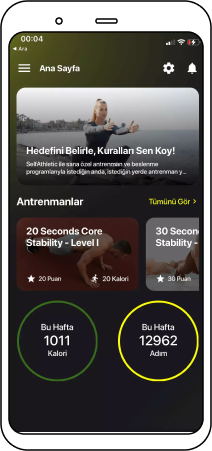What is SEO and Why is it So Important in Digital Marketing?
SEO (Search Engine Optimization) encompasses a series of technical and strategic efforts aimed at ensuring websites rank higher in search engine results. Its critical importance in digital marketing stems from the fact that a vast majority of internet users rely on search engines to find information, products, or services.
The significance of SEO lies in its ability to increase your website’s visibility, thereby attracting more organic (free) traffic. In other words, with the right SEO strategies, you can ensure that potential customers find and visit your site. This process not only focuses on driving traffic but also aims to make that traffic qualified. When visitors arriving via search engines find the information or products they’re seeking on your site, your conversion rates can significantly improve.
SEO training enables you to thoroughly understand and effectively implement this process. The training covers vital topics such as keyword research, content optimization, technical SEO, and backlink strategies. These skills and knowledge help maximize your website’s search engine performance, supporting you in achieving your digital marketing goals. Taking SEO training provides a long-term competitive edge in the digital world and lays a strong foundation for sustainable success.
How Does Taking SEO Training Impact Your Career?
SEO training is an indispensable investment for anyone looking to build a career in digital marketing. Search Engine Optimization (SEO) consists of strategies and techniques designed to help websites rank higher in search engines. This training allows you to specialize in the field and gain a competitive advantage.
By taking this training, you’ll learn how search engines work, how to conduct keyword research, optimize content, and develop backlink strategies. These skills and knowledge make you more valuable in the digital marketing world and increase your employability. Whether working at digital marketing agencies, e-commerce companies, or starting your own business, this expertise positions you as a trusted professional in the eyes of clients or employers.
Gaining proficiency in SEO, a cornerstone of digital marketing, can help you advance quickly in your career. This training equips you with the latest and most effective strategies, allowing you to stand out in the digital marketing landscape. As a result, you can secure a stronger position in the business world and achieve long-term success.
Taking SEO training offers a significant advantage for achieving sustainable success and a competitive edge in your career. With this training, you can establish a strong presence in the digital world and elevate your career to the next level.
What Core Topics Does SEO Training with Serdar Gürsoy Cover?
In my training sessions, I offer a curriculum that covers everything from the basic principles of SEO to in-depth technical details. We start with the fundamentals of technical SEO, where you learn the technical adjustments and improvements needed to make your website more crawlable and indexable by search engines. Next, we dive into content strategy, focusing on creating high-quality, original content, conducting keyword analysis, and optimizing content.
Backlink management is another key component of the training. I explain the role of acquiring strong, reliable backlinks in boosting your site’s authority and the methods to develop an effective backlink strategy. Finally, I teach the use of SEO analysis tools. We focus on tracking performance, generating reports, and developing strategies using tools like Google Analytics and Google Search Console.
This training is ideal for both beginners and those looking to reinforce their existing knowledge. My goal is to teach participants all aspects of SEO and empower them to achieve success with their own websites.
What is Keyword Research and How is it Done?
Keyword research is one of the most critical steps in SEO and forms the foundation of a successful SEO strategy. The goal of this process is to identify the terms your target audience uses in search engines and assess how competitive those terms are. The first step is to pinpoint keywords and phrases relevant to your niche. Professional tools like Google Keyword Planner, Ahrefs, and SEMrush are used to identify these keywords.
Next, you need to analyze the search volume and competition level of your chosen keywords. Keywords with high search volume but low competition are typically the most valuable. Additionally, targeting long-tail keywords is recommended. These are more specific and often less competitive, allowing you to achieve quicker and more effective results.
You optimize your website by strategically using these keywords in your content, meta descriptions, titles, and URLs. This increases your chances of ranking higher in search engines and boosting organic traffic. These techniques and more are covered in detail in my training sessions, helping participants develop successful SEO strategies.
How to Create SEO-Friendly Content?
Creating SEO-friendly content is vital for enhancing your website’s visibility in search engines. The process begins with keyword research to identify the terms your target audience frequently searches for. It’s important to naturally incorporate these keywords into your content’s titles, subheadings, and body text.
When creating content, prioritize user experience. Use short paragraphs, subheadings, and bullet points to make your content more readable. Additionally, providing informative and valuable content encourages users to spend more time on your site, which is viewed positively by search engines.
Incorporating images and videos also enhances content quality. Optimizing these media elements—such as using appropriate file names and alt text—helps search engines better understand your content. Adding internal and external links is also beneficial for SEO. Internal links direct users to other pages on your site, encouraging them to stay longer, while external links to credible sources boost your content’s authority.
These techniques and more are explored in detail in my training sessions, providing participants with comprehensive insights to develop successful SEO strategies.
What is Technical SEO and How Can I Optimize My Website?
Technical SEO involves optimizations that make your website more easily crawlable and indexable by search engines. This enhances your site’s performance, helping it rank higher in search results. One fundamental aspect of technical SEO is optimizing site speed. Reducing page load times improves user experience and is favorably evaluated by search engines.
Another key area is mobile-friendliness. Ensuring your site functions seamlessly on mobile devices provides a good experience across all devices and is a critical ranking factor for search engines like Google. Additionally, using the HTTPS protocol to secure your site protects user data and signals trustworthiness to search engines.
Using XML sitemaps and a robots.txt file, you can guide search engines on your site’s structure and which pages to crawl. Keeping URL structures simple and understandable is also important. Hierarchical, keyword-focused URLs benefit both users and search engines.
What Are Backlink Strategies and Why Are They Important?
Backlink strategies are crucial for increasing your website’s authority and search engine rankings. Backlinks—links from other sites to yours—demonstrate your site’s credibility and quality to search engines. Here are some effective backlink strategies and why they matter:
Securing backlinks from high-quality, relevant sites is essential. Links from authoritative and trustworthy sources enhance your site’s credibility in the eyes of search engines. Producing valuable, original content is key to achieving this, as other sites will want to reference your quality content.
Guest blogging is an effective way to earn backlinks. By writing articles for reputable blogs in your industry and including links to your site, you can gain backlinks while reaching your target audience.
The broken link strategy is another powerful approach. By identifying broken links on relevant sites and offering your content as a replacement, you can assist site owners while earning valuable backlinks.
Being active on social media and forums is another way to attract backlinks. Sharing valuable content on these platforms can drive more links to your site.
These strategies are covered in detail in my training sessions, equipping participants with comprehensive knowledge to build robust backlink strategies. Backlinks are a key factor directly impacting search engine rankings, and the right strategies can yield significant benefits.

What Are SEO Tools and When Should They Be Used?
SEO tools are indispensable for analyzing, optimizing, and monitoring your website’s performance. These tools offer a variety of functions tailored to different needs, helping you refine your SEO strategy. Here are some key SEO tools and their use cases:
Google Analytics: Used to track and analyze your website’s traffic. It helps you understand which pages attract the most visitors, which devices users are on, and how they behave on your site.
Google Search Console: Monitors and optimizes your site’s performance in Google search results. It allows you to see which keywords drive traffic, identify crawl errors, and address mobile usability issues.
Ahrefs: Ideal for backlink analysis, keyword research, and competitor analysis. Ahrefs helps you identify your backlink sources, assess their quality, and understand your competitors’ backlink strategies.
SEMrush: A comprehensive SEO tool offering keyword research, site audits, rank tracking, and competitor analysis. It aids in planning and optimizing your SEO strategy.
Moz: Used to analyze metrics like Domain Authority (DA) and Page Authority (PA). It also offers keyword research, site audits, and backlink analysis features.
Screaming Frog: Perfect for technical SEO audits. It helps detect crawl errors, broken links, missing meta tags, and more.
These tools can be used at various stages of your SEO process, each providing detailed insights for specific purposes. In my training sessions, I teach you how to effectively use these tools and interpret their data, enabling you to optimize your website and rank higher in search engines.
What is Mobile SEO and Why is it Important?
With the widespread use of mobile devices, ensuring your website performs well on these platforms has become essential. This requires a mobile-friendly, fast-loading site. Mobile SEO steps in to optimize your site’s performance on mobile devices, improving user experience and boosting your search engine rankings.
Learning and mastering mobile SEO offers a significant advantage in the digital marketing world. Since mobile-friendliness is a ranking factor for search engines like Google, expertise in this area enhances your site’s—or your clients’ sites’—competitiveness. For those new to the industry, understanding and applying mobile SEO is a key step to standing out in a digital marketing career.
This training program aims to comprehensively teach the fundamentals and advanced techniques of mobile SEO. It serves as an ideal starting point for anyone looking to improve their website’s performance or work professionally in this field. With this knowledge, you can grow in the digital world and secure a strong position in the industry.
What Are Local SEO Strategies and How Are They Applied?
Local SEO involves optimization efforts designed to help businesses or websites serving a specific geographic area reach potential customers in that region. These strategies aim to improve rankings in local search results and connect more effectively with your target audience.
One of the core local SEO strategies is creating and optimizing a Google My Business (GMB) profile. Ensuring your GMB profile contains accurate, up-to-date information—such as your business name, address, phone number, and operating hours—is crucial. Customer reviews and ratings also play a vital role in local SEO, as positive feedback builds trust with potential customers.
Conducting keyword research to identify terms used in local searches and incorporating them into your content is equally important. Producing local content—such as blog posts, event announcements, or local news—enhances your visibility in local searches.
Our training program covers the fundamentals of local SEO, along with the latest techniques and strategies in detail. Mastering the nuances of local SEO is a critical step for advancing your career in digital marketing or growing your own business.
What is the Connection Between SEO and Content Marketing?
SEO and content marketing are foundational pillars of digital marketing and are closely intertwined. While SEO focuses on optimizing a website’s technical structure and content to achieve higher search engine rankings, content marketing aims to attract and retain an audience by delivering valuable, engaging content.
A strong SEO strategy relies on quality content. Search engines prioritize sites that provide the most relevant and valuable information to users’ search intent. This is where high-quality content comes into play. By conducting keyword research, you can understand what users are searching for and strategically integrate those keywords into your content. However, it’s not just about keywords—offering real value to readers is equally important.
Content marketing boosts SEO success. Well-structured, optimized content captures search engines’ attention and helps you climb the rankings. Furthermore, when quality content is shared and linked to by other sites, it increases your site’s authority—a positive factor for SEO.
Our training helps you understand this critical connection between SEO and content marketing, offering strategic approaches to strengthen your digital assets.
What Are Common SEO Mistakes and How to Avoid Them?
Common SEO mistakes can negatively impact your site’s visibility and performance. One frequent error is keyword stuffing—overusing keywords in content—which search engines penalize. Creating natural, user-focused content is the best way to avoid this mistake.
Another common mistake is neglecting mobile-friendliness. With mobile searches on the rise, a site that’s slow or poorly displayed on mobile devices can lose users and drop in rankings. Ensuring mobile compatibility and fast load times resolves this issue.
Relying on low-quality backlinks is another pitfall. Links from irrelevant or spammy sites can harm your site’s reputation. Focusing on natural, high-quality backlinks from authoritative sources boosts SEO success.
What’s Expected in Future SEO Trends?
The SEO landscape is constantly evolving, and staying ahead of future trends is crucial for digital success. In the future, artificial intelligence (AI) and machine learning are expected to significantly influence SEO strategies. Search engines will increasingly leverage these technologies to deliver more personalized, meaningful results, shifting focus from keyword-centric approaches to user-intent-driven strategies.
The rise of voice search is another notable trend. With growing use of smart devices and voice assistants, optimizing for voice search will become essential. This requires structuring content in a natural tone and focusing on long-tail keywords.
Video content’s impact on SEO is also set to grow. Videos have high engagement potential and are valued by search engines, making video SEO strategies critical for future success.
What Are Google Algorithm Updates and Their Impact on SEO?
Google algorithm updates are significant changes to the search engine’s ranking criteria, profoundly affecting SEO strategies. These updates aim to make search results more user-friendly and higher quality. Aligning your SEO practices with these updates directly influences your site’s ranking success.
The Panda Update targets content quality. Low-quality, duplicate, or thin content can lead to ranking drops. Consistently providing original, valuable, and in-depth content is key to aligning with Panda.
The Penguin Update focuses on backlink profiles. Manipulative or low-quality links can harm your rankings. Securing natural, high-quality links from authoritative sites ensures compliance with Penguin.
The Hummingbird Update enhances search engines’ ability to understand user intent and natural language. It prioritizes long-tail keywords and meaningful, contextual content. Ensuring your content aligns with users’ search intent is vital for Hummingbird.
The BERT Update emphasizes natural language processing and contextual analysis. It better interprets search queries, requiring content to be written naturally and fully address user queries.
To stay ahead of future updates, keeping your SEO strategies current and adaptable is essential. Our training delves into these updates and their SEO impacts, combining this knowledge with practical strategies to ensure your site ranks successfully. With this comprehensive understanding, you can gain a competitive edge and achieve sustainable SEO success.
How is SEO Performance Measured and Reported?
Measuring and reporting SEO performance is critical for evaluating the success of your digital marketing strategies. Start by tracking organic traffic. Using Google Analytics, you can analyze the number of visitors arriving via search engines and their behavior, identifying which pages perform best and how long users stay.
Keyword rankings are another key metric. Tools like SEMrush or Ahrefs allow you to monitor your positions for target keywords, highlighting strengths and areas for improvement.
Conversion rates reveal the business value of your SEO efforts. Tracking whether visitors complete specific goals (e.g., purchases or sign-ups) shows how effective your strategies are. Google Analytics’ conversion tracking features are useful here.
Technical SEO analysis assesses site speed, mobile-friendliness, and overall health. Google Search Console helps identify and resolve technical issues.
Backlinks and on-page optimizations are also critical components. Tools like Ahrefs or Moz let you monitor backlinks, while on-page SEO elements can be refined for better performance.
Regularly reporting this data allows you to assess your strategy’s effectiveness and make improvements. Our training teaches you these processes in-depth, empowering you to enhance your SEO strategies. Join the training to discover how to maximize your SEO performance.
What Does the SEO Training Process with Serdar Gürsoy Entail?
Taking SEO training is one of the most effective ways to strengthen your digital marketing strategies. This training process blends theoretical knowledge with practical applications. Offered from beginner to advanced levels, it caters to participants of all experience levels.
The initial phase covers SEO’s core concepts and how search engines operate. Topics like keyword research, on-page and off-page SEO techniques, backlink strategies, and content optimization are explored in depth. This theoretical knowledge is reinforced with real-world examples and case studies, enabling participants to apply what they learn immediately.
In the practical segment, participants get hands-on experience analyzing and improving their own websites. You’ll learn how to use tools like Google Analytics and Google Search Console to monitor your site’s performance. Steps to identify and resolve technical SEO issues are also taught.
By the end of the training, participants gain the knowledge and skills to craft their own SEO strategies, equipping them with a competitive edge in digital marketing.
Competitor Analysis and SEO: How Can I Turn Competition into an Advantage?
Competitor analysis and SEO are vital for standing out in the digital world. By accurately analyzing your competitors and leveraging this data strategically, you can optimize your SEO efforts and gain a competitive edge.
Know Your Competitors: The first step is identifying your competitors. Determine the keywords they rank for and analyze who’s leading in those areas. Understanding their content types, target keywords, and structure shapes your strategy.
Analyze Their SEO Strategies: Studying your competitors’ SEO tactics reveals their techniques. Examine their backlink profiles, top-performing pages, and technical SEO practices to identify your gaps and opportunities.
Identify Opportunities and Turn Them into Advantages: Competitor analysis often uncovers weaknesses. Exploit these by targeting underserved long-tail keywords or improving neglected technical SEO aspects to outrank them.
Stay Current: The digital landscape evolves constantly, as do your competitors’ strategies. Regularly revisiting competitor analysis keeps you aligned with trends, algorithm updates, and industry shifts.
These steps not only help you understand your competitors but also turn their strategies into your advantage. To truly succeed in SEO, mastering these analyses and techniques is key.
Why is Choosing the Right Keywords Crucial for SEO?
Selecting the right keywords in SEO is vital for your online success. Keywords act as a bridge, connecting your target audience to your content. Knowing what terms your potential customers search for helps you address their needs, ensuring they find your content when they need it. Well-chosen keywords drive traffic and boost conversions by reaching the right people.
Keyword selection also plays a critical role in competing with others. Opting for specific, less competitive keywords over highly contested ones can set you apart, helping you reach a niche audience and build authority. This is especially advantageous for beginners and small businesses.
When crafting content, the right keywords shape its structure and focus. Content that engages users and answers their questions not only satisfies visitors but also improves your search engine rankings. This process requires ongoing updates and trend monitoring, as SEO is dynamic—keeping your keywords and strategies fresh ensures you stay competitive.
What Are SEO Strategies for E-commerce Sites?
SEO strategies for e-commerce sites enhance visibility in search engines and attract potential customers. Given the fierce competition in e-commerce, a robust SEO strategy is essential. Here are some key strategies for e-commerce SEO:
Keyword research is the backbone of e-commerce SEO. Understanding what your customers search for is the first step to optimizing product pages. Choosing unique, targeted keywords for each product ensures users find what they’re looking for on your site.
On-page SEO is indispensable for e-commerce. Using keywords in product descriptions, titles, and meta descriptions helps search engines categorize your pages correctly. Additionally, fast-loading, mobile-friendly pages with easy navigation enhance user experience.
Technical SEO must not be overlooked. Keeping sitemaps updated, optimizing URL structures, and using internal links effectively make it easier for search engines to crawl and index your site. An SSL certificate ensures security, benefiting both SEO and user trust.
Image optimization is often neglected in e-commerce. Optimizing product images—reducing file sizes and adding relevant alt tags—improves load times and boosts visibility in image searches.
A content strategy is integral to e-commerce SEO. Blogs, guides, and product reviews add value for customers and keep them on your site longer. Addressing common customer questions through content can drive traffic directly to you.
Strengthening your e-commerce site’s SEO is a cornerstone of digital marketing success. Comprehensive training in these strategies and beyond can give you an edge over competitors. Our training covers these tactics in-depth, helping you optimize your e-commerce site and boost sales. Gaining these skills is one of the most effective ways to elevate your business in the digital world.
How Can SEO Training Help You Stand Out in Digital Marketing?
SEO (Search Engine Optimization) training is invaluable for standing out and achieving sustainable success in digital marketing. The SEO training I provide goes beyond theoretical knowledge, empowering participants with practical applications. One key way it stands out is through its comprehensive, up-to-date content. SEO is an ever-evolving field, making mastery of the latest strategies essential. The training is continually updated to reflect current algorithm changes and best practices, ensuring participants understand how to adapt to Google’s latest updates.
The training combines theory with hands-on practice. Real-world scenarios allow you to apply what you’ve learned immediately, reinforcing theoretical knowledge with practical experience. Keyword research, a cornerstone of SEO, is covered in detail—teaching you how to select the right keywords and integrate them into your content strategy to effectively reach your audience.
Technical SEO knowledge is another critical component. You’ll gain expertise in site speed optimization, mobile-friendliness, URL structuring, and sitemaps, enabling you to boost your site’s performance and rankings. Analysis and reporting skills are also emphasized, with training on tools like Google Analytics and Google Search Console to monitor performance, identify issues, and refine strategies.
Competitor analysis is a key to gaining an edge. You’ll learn how to dissect competitors’ SEO tactics and leverage this insight to outpace them. For businesses targeting local audiences, local SEO strategies teach you how to increase visibility in local search results and grow your customer base.
My SEO training not only equips you with knowledge and skills but also teaches you how to optimize and evolve your digital marketing strategies. With this comprehensive training, you’ll gain the tools to stand out, enhance your website’s performance, reach your audience more effectively, and surpass competitors in the digital marketing landscape.



















